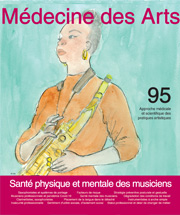Revue Médecine des Arts N°95 Physical and mental health of musicians

Revue Médecine des Arts N°95 Physical and mental health of musiciansArtists' health, musician's health
Issue 95 Physical and mental health of musicians
Medical and scientific approach to artistic practices
Free Shipping
The articles of the journal are not sold independently, the price of 17 euros corresponds to the price of the whole magazine, all articles and chronicles.
The Covid-19 pandemic plunged the music profession into an unprecedented situation, with singular medico-social consequences depending on social status and individual circumstances. The physical and mental health of musicians was noticeably affected during this period, and perceptibly so after the pandemic.
The system used to carry instruments while playing is not without consequences for the physical problems reported by musicians, and the main aim of this study was to investigate whether there is a causal link between the musculoskeletal disorders associated with musical performance (MSDs) observed in adult saxophonists and the type of carrying system used. Wind instrumentalists often encounter problems relating to the quality of the detachment. We reviewed the literature on the position of the tip of the tongue for detachment in single-reed players. Tongue-toning exercises are offered to wind players.
Art is a lie that tells the truth EDITO N°95
AbstractWhen we're interested in art, we're astonished by its astonishing truth. What it tells us about people, places, times and events.
Read more in issue 95 ....
Position of the tip of the tongue in single reed wind players for single tonguing
AbstractThe quality of single-tonguing is one of the most common problems encountered by wind players. When single tonguing, musicians articulate different phonemes ("ta", "ka", "da", "ga", etc.) depending on the musical effect desired. We know how to position the tongue to produce these sounds when we don’t have the instrument at hand. The tip of the tongue (the apex) is an important concept in lingual rehabilitation, particularly for the pronunciation of the palatals sounds (L, N, D, T) that are useful to musicians. But where should the apex be positioned when playing the instrument? Method: A review of the literature on the position of the tip of the tongue for tonguing in single-reed instrumentalists was carried out by means of a bibliographic search of various scientific databases. Results: 12 references were selected to address this issue. Conclusion: The tongue should work in the same way with and without an instrument. For single tonguing with the "T" or "D" sounds, the tip of the tongue is placed over the tip of the reed to stop the vibration and to articulate the notes. The movement of the tip of the tongue is difficult to objectify with current imaging in relation to the back or rear of the tongue. In addition, there is no consensus on the best technique for single tonguing due to the variety of techniques used by musicians and the difficulty of proprioception in this anatomical area. As a result of this research, tongue toning exercises are being offered to wind instrumentalists.
Playing-related disorders in saxophonists and the role of strap/harness systems
AbstractProfessional musicians: how has the Covid-19 period affected their musical practice and health?
AbstractThe Covid-19 pandemic has plunged the musical profession into an unprecedented situation, with very specific medical and social consequences depending on the social status and the individual concerned. The cross-sectional descriptive study carried out by Médecine des Arts in 2023, using several validated questionnaires, examined the physical and mental health of French professional musicians in the wake of the Covid-19 pandemic. One section of this study asked musicians ten questions about the impact of the Covid-19 period on their professional activities and on their physical and mental health; the results and analysis of this section are the subject of this article.
The data from the 338 respondents show that the Covid-19 period has profoundly altered musicians’ relationships with their professional practice and their health. About a third of the musicians surveyed said that they were working at a faster pace, that their working conditions had deteriorated, that they felt socially isolated, that they wanted to change jobs, and that they felt less socially useful. A fifth said they felt less involved in their work, and a quarter said their lifestyle was less healthy than before. More than 40% expressed insecurity with regard to their work compared to the period before Covid-19. Finally, 40% of professional musicians said that their physical and mental health has deteriorated compared to the period before Covid-19.
Significant disparities, highlighted by the unprecedented situation of the Covid-19 pandemic and lockdowns, exist, and vary according to age, gender, status (public service, casual sector worker, salaried, etc.), practice (instrument, voice), main type of practice (orchestra, teaching, popular music, etc.), length of professional practice and intensity of daily practice. These differences must be taken into account in order to identify and introduce appropriate preventive measures.
Version papier
17€
Subscription, France, EEC (1 year, 2 issues)
34€
Subscription Outside EEC (1 year, 2 issues)
37€
Les garanties médecine des arts
Articles en stock
Envoi dans les 24h
Paiement
en ligne sécurisé
Une question ?
